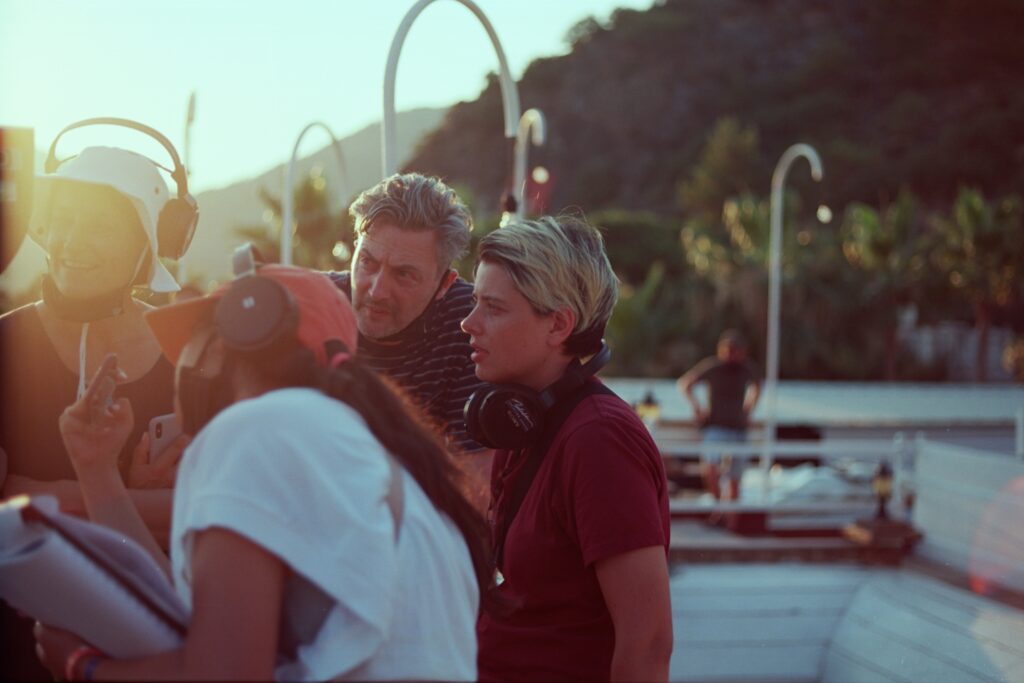
Aftersun by Charlotte Wells magnifies what seems insignificant
Year
Runtime
Director
Writer
Cinematographer
Production Designer
Music by
Format
Genre
Subgenre
By
The film felt tiny.
Paul Mescal
The reflection of Irish actor Paul Mescal, a rising star in today’s international cinema, may seem odd for a film that, among its many accolades, was lauded at the 75th Cannes Film Festival, recognized with a nomination for Mescal’s performance at the 95th Academy Awards, highly honored at the 76th British Academy Film Awards and the 25th British Independent Film Awards, and ranked number one in Sight and Sound‘s poll of the 50 best films of 2022. But Aftersun, Scottish director and writer Charlotte Wells’ directorial debut about the relationship between a young girl and her father, magnifies what seems insignificant.
Aftersun has left its mark on critics and audiences, for communicating many of the complicated emotions inherent to child-parent relationships. Along with the thoughtfully crafted film and early digital aesthetic, lyrical editing, and the 1990s time capsule of a soundtrack, Wells has succeeded in creating a work at once singular and universal.

Memory as Video
First, we hear the sound of tapes – rewinding, ejecting, loading. Then we recognize the pixelated images and colors of early digital video. We see clips of a father and daughter on vacation, and only when the video stops can we discern the reflected face of the adult woman watching the tapes.
Aftersun can be categorized as a character study. Not much happens as 11-year-old Sophie (Frankie Corio) spends a holiday at a Turkish resort with her young father, Calum (Paul Mescal), and the two make use of their new camcorder. It’s clear early on that Sophie’s mother and Calum are separated, and that the latter – though idealistic at times – is devastatingly lost and showing signs of depression. Still, he pours all of his love into his clever daughter. Intercut with the holiday is a dreamlike rave sequence in which the adult Sophie (Celia Rowlson-Hall), a new mother, reaches for her still-young father’s dancing and breathless figure. She is the woman who plays the tapes.
We don’t know what prompted Sophie to go through this old footage, nor do we ever get the context of what happened between father and daughter in the years since their vacation. So much is left to the imagination as Aftersun focuses on the fragmented moments of their time together, all filled with love and an inescapable undercurrent of melancholy.
Designing the Holiday
After years of crafting Aftersun and developing the script at the 2019 Sundance Screenwriters Lab, Wells set out to cast the two roles upon which the entire film rests. After their first meeting, she was certain about Mescal, having seen his performances in The Lost Daughter and Normal People. Since reading the screenplay in one sitting, Mescal was already passionate about bringing her script to life. To find Frankie Corio, Wells and casting director Lucy Pardee reviewed more than 800 video submissions over six months. Ultimately, “live auditions revealed that Corio was not only readily organic, her reactions and transparency were endlessly fascinating to the camera” (Aftersun Press Notes). Mescal and Corio spent time developing a comfortable relationship off-camera to easily translate their father-daughter relationship to the screen. Thus, Wells could craft the atmosphere surrounding them.
With Aftersun, Wells and cinematographer Gregory Oke continue their collaboration, which began as classmates at NYU. To create the visual language of Sophie’s memory, they first referenced their own photographs of family holidays and took inspiration from the rich color palettes. In Sophie’s memory, the world is vibrant with reds and blues.
Those photos were also massively important in thinking about the retrospective gaze. The film’s unifying perspective is adult Sophie sitting in her apartment looking at these old tapes, but contained within that are a lot of different views or gazes. Sometimes we are looking at a direct sense-memory. Sometimes it is memory retold as a story, and at other times, we are looking at something imagined or fantasized when Sophie wasn’t there or wasn’t conscious.
Gregory Oke (from Aftersun Press Notes)
The resulting visceral imagery is powerful and supports the naturalistic exchanges between Frankie and Calum. These moments become the subtle, beating heart of the story.
A Generational Pivot
Calum and Sophie’s vacation takes place in the late 1990s, an era marked by technological innovation. They make use of their new MiniDV camera to record their holiday. The timing of this device and the aesthetics of early digital video in a 2022 film is just right: digital is back; at least among Gen Z.
The resurgence of digital camera aesthetics follows the comeback story of Polaroids in the mid-2010s, demonstrated by – and due to – the trendiness of devices like the Fujifilm Instax Mini. Gen Z has also revitalized participation in analog film. As of this writing, disposable cameras are trending to achieve the now-coveted late 1990s/early 2000s look. The pattern is clear: young people are nostalgic for physical media.
Film stimulates a tactile sensation. You can hold onto it. You can see the effects of age and usage on a strip. […] It scratches just like our bodies do. It decays like our bodies do. […] Whereas the same digital image remains somewhere in a digital verse, achieving perhaps a level of perfection that’s inorganic and inhuman-like.
The Return of Analog Film in a Digital Age by Ray Shehadeh
In an age of rapid digitization and reliance on intangible storage such as the cloud, it makes sense that a generation raised amidst structural, societal uncertainty would turn to more guaranteed forms of saving memories. Older forms of media also provide a perceived authenticity that, in the digital world, is more jeopardized by the day with the advent of AI and deepfakes. Aftersun demonstrates the emotional value and unique ritual of physical media as Sophie revisits memories of her father by popping tapes into the DVD player.
Making and Watching
Much like the Turkish rug that Calum admires in a shop and which Sophie eventually inherits, the film is a beauty of individual threads. Only upon stepping back can we appreciate what Charlotte Wells has woven: a child’s attempts to understand their parent.
In a meta-cinematic way, Aftersun comments on the potential of art as a tool for understanding one another and our relationships. Just as the adult Sophie watches old tapes, Wells makes a film that she has called deeply personal. Like Vietnamese-American poet and novelist Ocean Vuong‘s exploration of a child-parent relationship, On Earth We’re Briefly Gorgeous, Aftersun is an autofiction that allows for imaginative diversions from reality. Both in the story and real life – whether a person is holding the camera or watching the footage – Wells’ choices suggest that film can be a cathartic exercise and a tool for creating meaning.
Calum and young Sophie take turns recording one another, capturing precious instants of their relationship. In the film’s final moments, adult Sophie points the recorder directly at us. The shot slowly turns to Calum, also pointing the recorder at the audience, before he packs it up and walks away. The effect is that father and daughter are watching each other, trying to understand each other, simultaneously and separated by time. It’s also a fourth-wall break, implicating us as the audience in this act of watching to understand. Wells, making to understand, poses an existential question: Will we ever truly understand one another? And is it worth it, anyway, to try?

Video as Memory
The footage Sophie and Calum capture on holiday could tell a thousand different stories, depending on who is watching. The elusiveness of what these memories and digital souvenirs mean to the adult Sophie watching them serves to demonstrate just how subjective art, memory, and indeed reality actually is – it is a tremendous demonstration of the power of each of us, the viewers, in making meaning out of memories and video.

Tag
Buy a ☕ for Hypercritic










